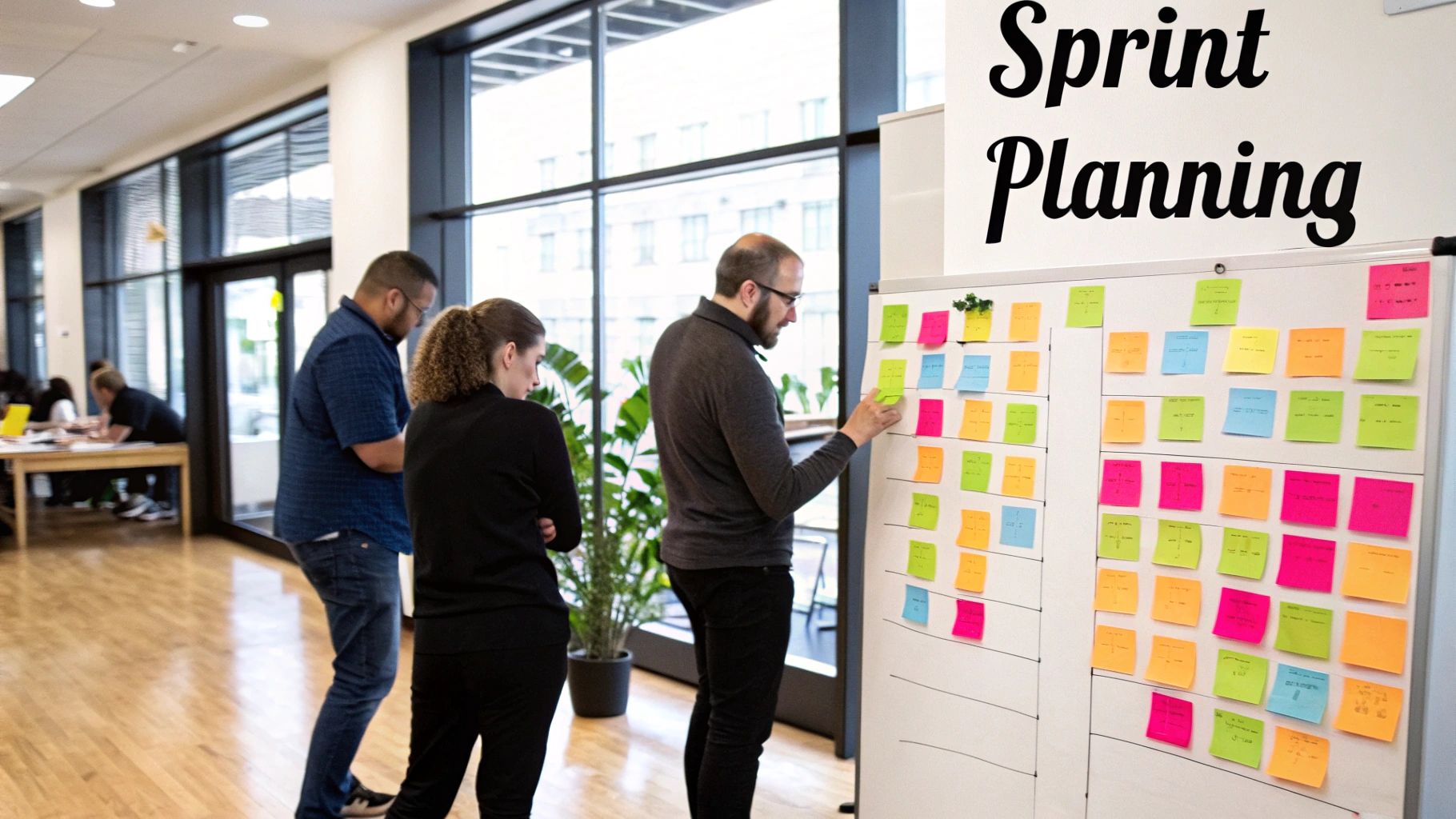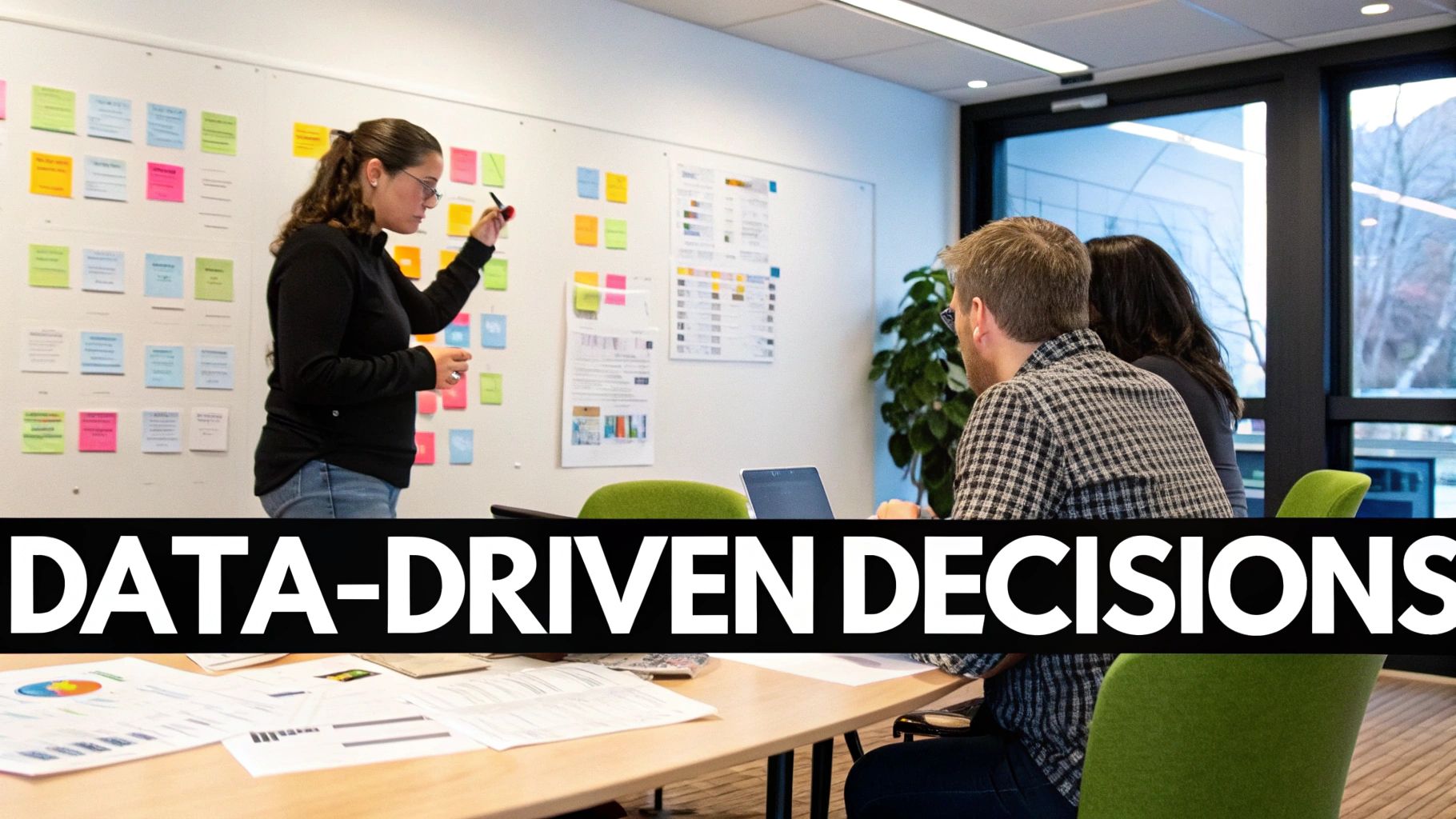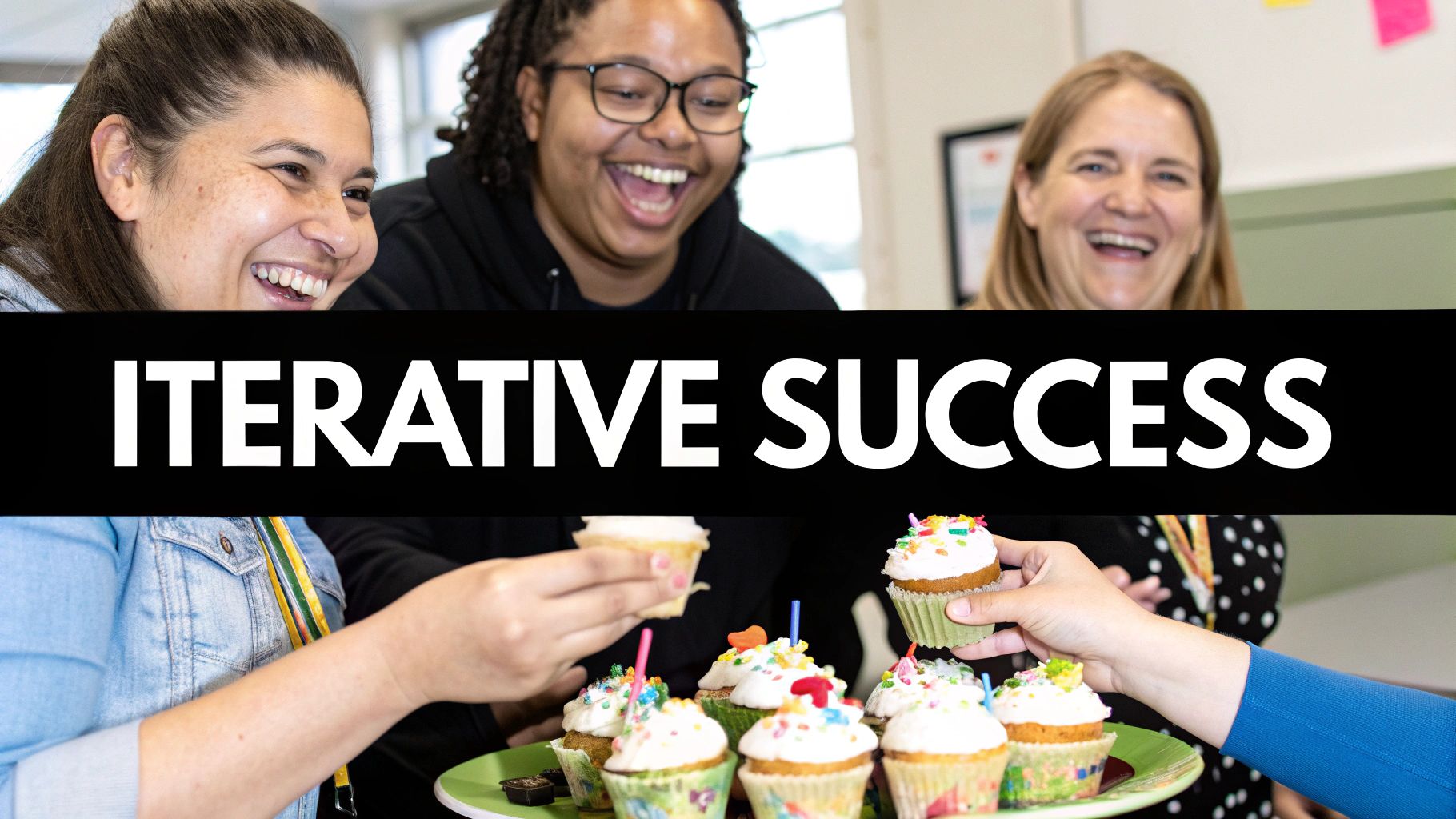The Real Impact of Modern Agile Development

The way we build software has fundamentally changed. Agile development practices have moved beyond buzzwords to become an essential approach that directly impacts how teams work together and deliver results. Let's explore the real, measurable ways agile practices are helping organizations succeed.
Quantifiable Benefits of Agile
The numbers tell a compelling story about agile's effectiveness. Research consistently shows that agile projects have much better success rates than traditional waterfall approaches. This makes sense – by working in small iterations and getting frequent feedback, teams can spot and fix issues early. For instance, many teams report shipping features 30-50% faster after adopting agile methods. Quick delivery means businesses can respond to market opportunities faster and stay competitive.
The Role of Continuous Improvement
At its heart, agile emphasizes getting better over time through regular reflection and adjustment. Teams hold retrospective meetings to discuss what's working well and what needs to change. This creates a natural cycle of learning and growth – much like athletes reviewing game footage to improve their performance. Teams that stick with this practice typically see steady gains in both their speed and quality of work. The key is making small, focused improvements each sprint rather than attempting massive changes all at once.
Adapting Agile to Scale
While agile started with small teams, its core ideas work just as well for larger organizations when applied thoughtfully. Frameworks like Scaled Agile Framework (SAFe) and Large-Scale Scrum (LeSS) provide practical ways to coordinate multiple agile teams without creating bureaucracy. Success at scale requires clear communication channels between teams and shared goals that keep everyone aligned. When done well, even organizations with hundreds of developers can maintain the flexibility and quick response times that make agile powerful.
Overcoming Challenges in Agile Adoption
The shift to agile isn't always easy. Common hurdles include resistance from team members used to traditional methods, confusion about agile concepts, and friction with existing company processes. Success requires investing in proper training, having leaders actively support the change, and recognizing that agile practices may need adjustment for your specific context. The most successful adoptions focus on the principles behind agile rather than rigidly following any specific methodology. This flexible mindset helps teams find the right balance between agile ideals and practical constraints.
Remember – adopting agile is ultimately about building better software through collaboration, adaptability, and continuous learning. When teams embrace these fundamentals while staying pragmatic about implementation, they're well positioned to see meaningful improvements in both their work and results.
Creating an Agile Culture That Actually Sticks

Building real agile practices goes far beyond just following a set of rules and ceremonies. The heart of successful agile adoption lies in fostering the right mindset and culture across your entire team. When teams embrace agile principles authentically, they unlock remarkable improvements in how they work together and deliver value. Let's explore how to create an agile culture that genuinely transforms how teams collaborate and achieve results.
Fostering a Mindset of Collaboration and Trust
Great agile teams thrive on open dialogue and shared responsibility. Team members need to feel safe expressing ideas, raising concerns, and working closely with colleagues across different roles. For instance, encouraging practices like pair programming helps break down barriers between team members while promoting knowledge sharing. Making it safe to experiment and learn from setbacks is equally important – when teams know they won't be blamed for honest mistakes, they're more likely to innovate and find better solutions. This foundation of psychological safety and trust enables the continuous learning that makes agile powerful.
Embracing Change and Continuous Improvement
The ability to adapt smoothly to new information and circumstances sets successful agile teams apart. Rather than seeing changes as disruptions, effective teams treat them as valuable opportunities to learn and get better. Regular retrospectives provide a structured way for teams to reflect on what's working well and what could improve. The key is keeping these sessions focused on specific actions teams can take, not pointing fingers. When teams commit to honest reflection and making incremental improvements, they build momentum that compounds over time.
Leadership's Role in Cultivating Agile Culture
Leaders play an essential part in helping agile culture take root and flourish. This means actively demonstrating agile behaviors – being transparent about information, participating fully in agile ceremonies, and consistently supporting teams as they adopt new ways of working. When leaders show this kind of visible commitment, it signals that agile isn't just another passing initiative but a real priority for the organization. Research backs this up – companies where leaders actively champion agile see employee engagement increase by 76% on average.
Practical Tips for Building an Agile Culture
Creating lasting cultural change requires sustained focus and effort. Here are some concrete ways to start building stronger agile practices:
- Start Small and Iterate: Focus on mastering a few key principles before expanding. Build confidence through early wins.
- Invest in Training and Coaching: Give teams the knowledge and support they need to apply agile concepts effectively.
- Celebrate Successes and Learn from Failures: Recognize team achievements while treating setbacks as chances to improve.
- Continuously Adapt and Refine: Regularly check how your practices are working and adjust based on team feedback.
By focusing on these fundamentals, teams can develop an agile mindset that goes far beyond just following procedures. When agile becomes "how we work" rather than "what we do," teams unlock dramatic improvements in how they collaborate, solve problems, and deliver outstanding results.
Making Scrum and Kanban Work Together
Strong agile practices are key for software development teams to thrive. While teams often start with either Scrum or Kanban, sticking too rigidly to just one framework can hold them back. More and more teams are discovering the power of thoughtfully combining both approaches. Let's explore how to make these two methods work together effectively.
Understanding the Strengths of Each Framework
Scrum and Kanban each bring distinct advantages to the table. Scrum provides clear structure through defined sprints and roles, making it perfect for projects with firm deliverables and deadlines. Kanban shines by keeping work flowing smoothly and adapting quickly to change – ideal when requirements shift often or teams need to deliver continuously. Recognizing these complementary strengths is essential for bringing them together successfully.
Combining Scrum and Kanban: Practical Strategies
The key to blending these approaches is finding the right balance. Many teams use Scrum to set the overall rhythm with sprints and ceremonies, while managing day-to-day work using Kanban boards and flow principles. This gives them Scrum's helpful structure while keeping the flexibility to adapt within sprints.
For instance, a mobile app team might plan two-week sprints with clear goals, but track individual tasks on a Kanban board during the sprint. This helps them spot bottlenecks early and keep work moving smoothly.
Adapting to Your Team's Needs
Every team is different, so there's no one-size-fits-all solution. Some teams lean more heavily on Scrum's structure, while others prefer Kanban's fluid approach. The best mix comes through experimentation – perhaps starting mostly with Scrum and gradually bringing in Kanban elements, or vice versa.
Optimizing Workflow with a Hybrid Approach
Using both frameworks opens up powerful possibilities for improving how teams work. Kanban boards make it easy to see where work is getting stuck and how to improve. This visibility helps teams communicate better and work together more smoothly. Setting work-in-progress limits helps teams focus and finish tasks more reliably.
The combined approach also handles mid-sprint changes gracefully. When urgent work comes up, teams can add it to their Kanban board and adjust without derailing sprint goals. This balance of structure and adaptability gives teams the best of both worlds. When thoughtfully implemented, bringing Scrum and Kanban together creates a strong foundation for delivering great software sustainably.
Mastering the Art of Iterative Development

The path to building great software lies in mastering iterative development. When teams embrace constant refinement and improvement, they can create products that truly serve user needs. Let's explore how successful teams put iteration into practice through testing, feedback, and continuous learning.
The Power of Continuous Testing
Testing shouldn't be an afterthought – it needs to be woven into every stage of development. Take a team building a new e-commerce feature: Rather than waiting until the end, they test each component as they build it. This catches issues early when they're easier and cheaper to fix. The numbers back this up too – studies show that Agile projects have much lower failure rates compared to traditional methods. By finding and fixing problems quickly, teams can maintain momentum while ensuring quality.
Closing the Loop With Meaningful Feedback
Getting feedback is only half the battle – you also need to act on it effectively. The best teams gather input from multiple sources, not just developers. Product owners and end users provide crucial perspectives that shape the direction of the product. When teams truly listen to their users and adapt accordingly, satisfaction rates soar – some organizations report 93% customer satisfaction after fully adopting Agile practices. Regular check-ins with stakeholders keep development aligned with real needs.
Sprint Retrospectives: The Engine of Continuous Improvement
Sprint retrospectives give teams dedicated time to examine what's working and what isn't. Much like athletes reviewing game footage, these meetings help teams spot opportunities to improve. For instance, if daily standups are getting too long, the team might try new meeting formats in the next sprint. The key is focusing on learning rather than blame. Small refinements add up to major gains in both speed and quality over time.
Balancing Speed and Quality in Iterative Development
Some worry that moving quickly means cutting corners on quality. But when done right, iteration actually improves quality by catching issues early. Teams that combine continuous testing with rapid feedback cycles prevent small problems from becoming big ones. Research shows that Agile teams achieve up to 250% better quality compared to teams without structured practices. The secret is maintaining focus – rather than trying to do everything at once, successful teams complete features thoroughly before moving on. This steady, purposeful approach lets teams stay nimble while delivering excellent results. Through constant learning and refinement based on real experience, teams unlock the full potential of iterative development.
Building Genuine Customer Collaboration

True customer collaboration takes Agile development to the next level. Moving beyond basic client meetings, successful teams create meaningful partnerships that drive incredible results. Let's explore how leading development teams balance close customer communication while protecting their productivity and focus.
Active Stakeholder Engagement Throughout the Development Lifecycle
Meaningful customer collaboration isn't a one-off event – it's woven into every sprint and phase of development. Regular touchpoints like sprint reviews and stakeholder demos help teams stay perfectly aligned with customer priorities. For example, teams use shared project boards and communication channels to maintain an open dialogue. This transparency builds trust and shared ownership between developers and clients.
Gathering Actionable Feedback and Managing Changing Requirements
The key to great collaboration is focusing on feedback that drives real improvements. Through techniques like user story mapping and collaborative workshops, teams uncover the true needs behind customer requests. This is especially important since research shows about 70% of software projects face scope changes. Clear communication helps teams smoothly handle evolving requirements while keeping projects on track.
Maintaining Team Focus During Intense Delivery Periods
While close customer collaboration is essential, development teams also need focused time to deliver great work. Too many interruptions can derail productivity. Smart teams set clear boundaries – for instance, scheduling specific times for client meetings and using async communication tools. This gives developers the quiet time they need while still being responsive to customers.
Balancing Customer Needs With Technical Constraints
Sometimes customer wishes don't align perfectly with technical realities. The best teams handle this through honest, constructive dialogue. By clearly explaining technical limitations and exploring creative alternatives together, they maintain customer trust even in challenging situations. This collaborative problem-solving often leads to even better solutions than originally planned. The goal is finding the sweet spot where customer needs and technical feasibility meet – creating successful outcomes that make both sides happy.
Measuring What Actually Matters in Agile
Success in agile development comes down to focusing on the right things. While surface-level metrics like sprint velocity can give a basic picture of output, truly effective agile teams go deeper to understand and measure the real impact of their work. Let's explore how leading organizations go beyond basic measurements to track what really drives value.
Choosing the Right Metrics for Your Agile Team
Velocity alone tells an incomplete story. Teams that focus solely on story points completed often end up cutting corners on quality or inflating estimates just to hit sprint goals. The most successful agile teams instead take a balanced approach, using multiple metrics that capture different aspects of project health.
Take a mobile app development team as an example. Rather than just tracking velocity, they might measure:
- Lead Time: The total elapsed time from story creation to production deployment – revealing end-to-end process efficiency
- Cycle Time: How long stories take once development starts – helping spot sprint bottlenecks
- Defect Escape Rate: The ratio of bugs found post-release vs. during testing – indicating testing effectiveness
- Customer Satisfaction: Direct user feedback on delivered features – the ultimate measure of value
This multi-dimensional view helps teams understand where they're performing well and where they need to improve.
Implementing Meaningful KPIs and Avoiding Metric Manipulation
The key is tying performance indicators directly to project and business goals. This keeps teams focused on delivering real value rather than just completing tasks. Building trust and transparency around metrics is also essential.
Best practices include:
- Making KPIs visible to everyone to foster alignment and accountability
- Including teams in KPI definition to build ownership and commitment
- Emphasizing continuous improvement over hitting arbitrary targets to prevent gaming metrics
For instance, a team aiming to boost feature engagement might track daily active users, session duration, and feature usage. Regular review of these metrics, combined with data-driven adjustments, creates a culture of meaningful improvement.
Scaling Agile Metrics Across Multiple Teams
As agile practices expand across an organization, consistency in measurement becomes critical. This means establishing shared definitions of key metrics and standardized tracking processes. A central dashboard aggregating data across teams can surface valuable insights and collaboration opportunities. However, avoid forcing identical metrics on all teams. Each group's unique context and objectives should inform their specific KPIs. While all teams might measure lead time, target values may vary based on project complexity. This balanced approach enables organization-wide visibility while empowering teams to optimize their own performance.
Transform your vision into a reality with MarkBox Studios. We specialize in helping founders and business owners develop MVPs and scalable solutions that drive business growth. From insightful weekly startup information to personalized consultations, we empower entrepreneurs to achieve their goals. Let us help you execute your project effectively and fuel sustainable success. Visit us today at https://www.markboxstudios.com to learn more.



